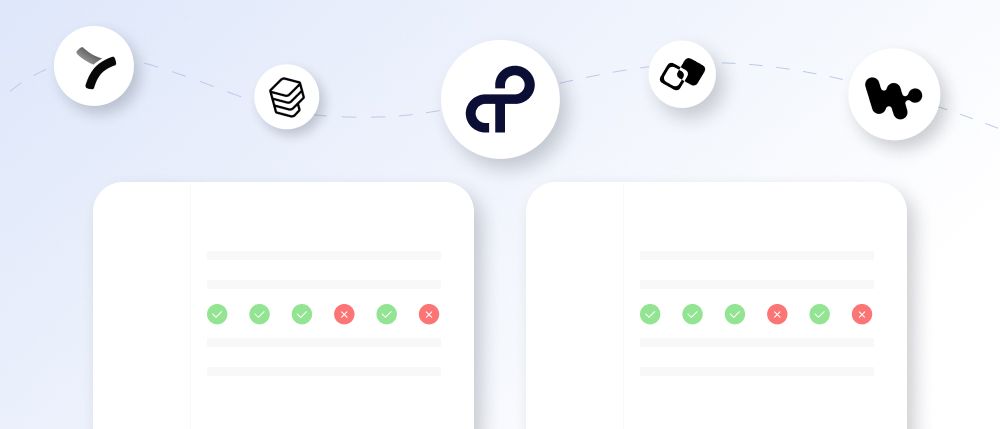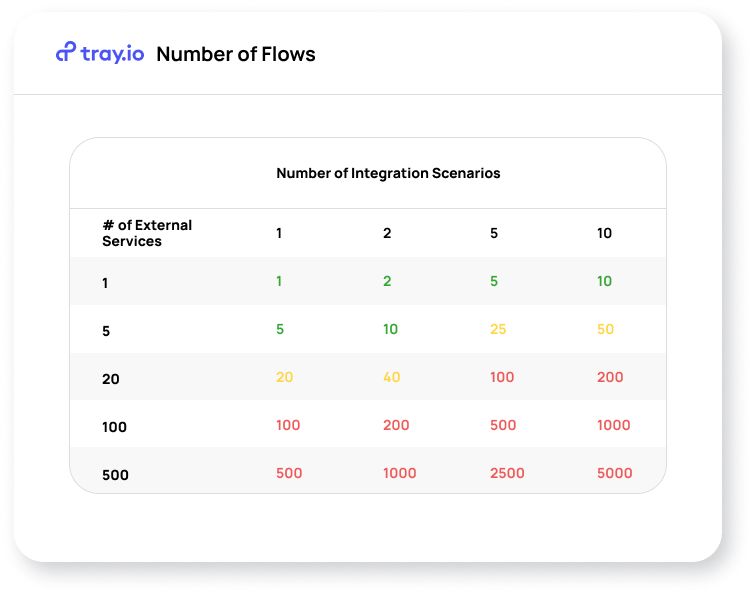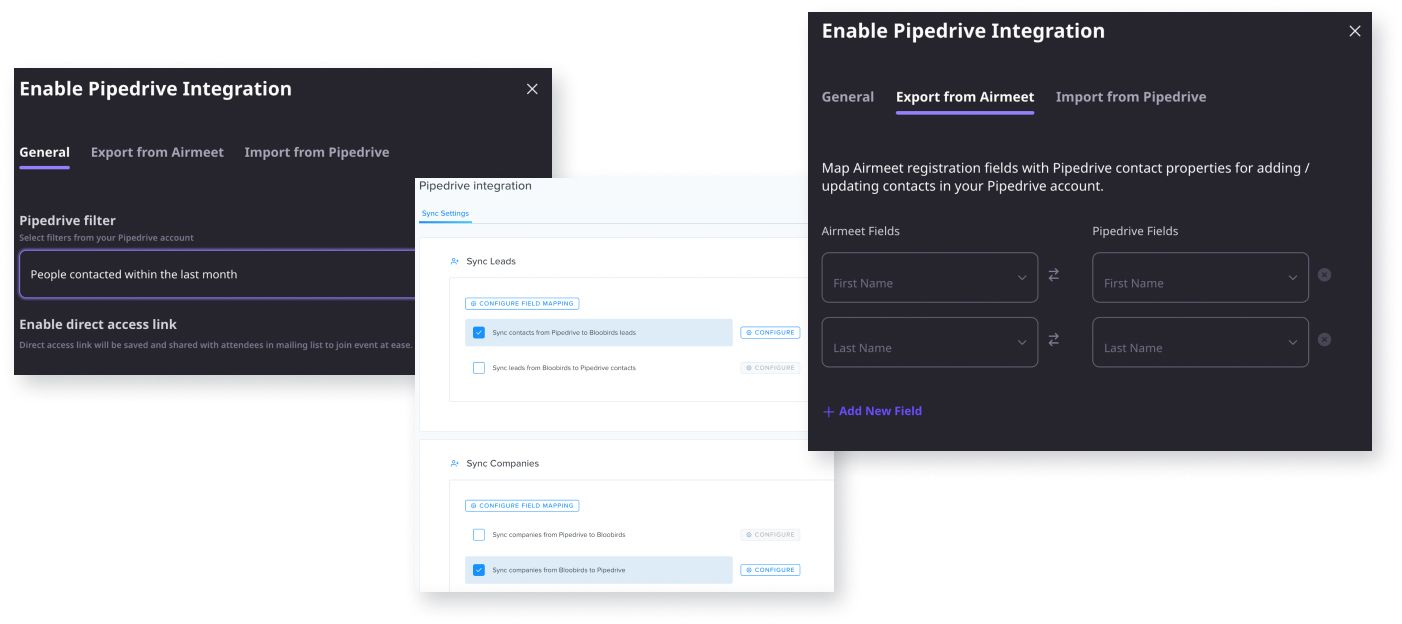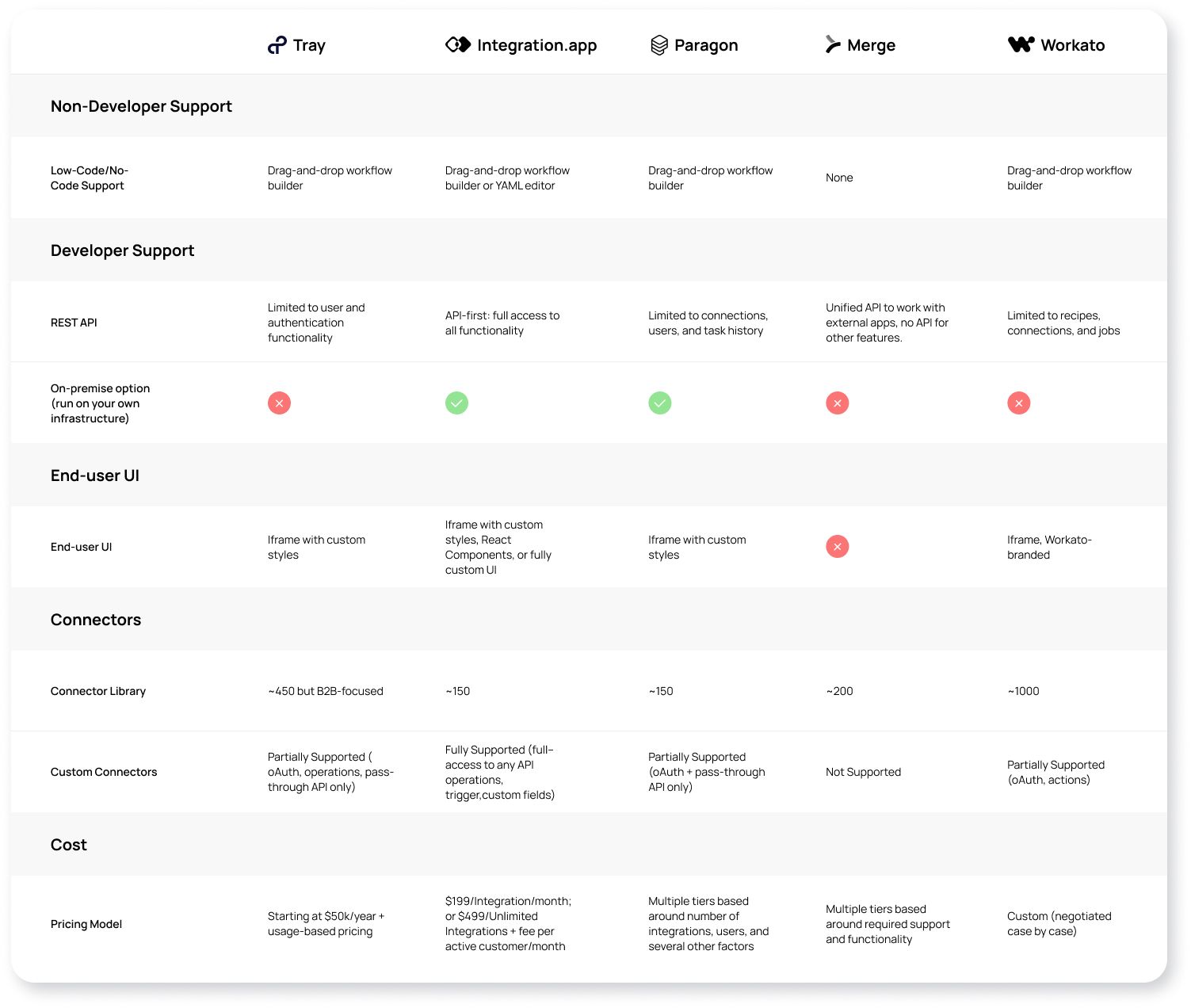
Top Four Tray Embedded Alternatives: Pros and Cons
Tray is often the platform by which alternative integration solutions are compared. Tray offers a large connector library and a rich visual workflow builder. However, since Tray wasn’t originally built for native embedded integrations, customers often find themselves building workarounds to fulfill their integration needs. While Tray does offer premium custom connector services, they do come at a premium price.
In addition to their main iPaaS offering, their Tray Embedded product allows customers to build embedded (partially-native) integrations.
Let’s take a closer look at the key advantages and disadvantages of Tray Embedded and the best alternatives to consider.
Key Advantages of Tray Embedded
There are two key points on what makes Tray a favorable choice.
Workflow Builder
Sitting at the core of Tray, is their visual workflow builder (shown below) which enables non-technical customers, to visually build integrations:
If you need to build a few workflows connecting your app with other apps, Tray will solve this problem well. Beyond that, you may experience scalability issues.
The workflow builder’s connector system, supplemented by its support for JSONPath expressions, makes the integration process easy, even for less-technical stakeholders with only a basic understanding of APIs and networking.
Connector Library
Tray Embedded inherited an extensive connector library from Tray’s existing iPaaS solution. This enables you to connect with a large portion of business applications which your customers likely use.
Key Disadvantages of Tray Embedded
Now, let's break down some of trade-offs you'll have by using Tray.
Lack of Custom Connectors
With Tray, you can't build your own connectors or modify existing ones. You have to request additions or updates from the Tray team and then wait for them. Needless to say, this will throw any production schedule off and create an unnecessary risk factor.
Lack of Scalability
Tray and many embedded iPaaS solutions don’t necessarily scale well when adding multiple integrations. For each external service you want to integrate with, you have to implement a new integration flow for each scenario you want to support. The following tables illustrate how these numbers compound:

As this table shows, the number of integrations required using Tray is a function of the number of scenarios to be supported and the number of apps you want to integrate with.
UI Customization is not Fully Integrated
Tray enables you to embed a simple customized UI via an iframe or popup that looks similar to the following:

Although you can customize the styles to roughly match your app’s, Tray’s UI will never feel like a part of your app.
Limited API
Another shortcoming of Tray is it’s API, which is limited to three main areas of functionality:
- Manage users
- Manage user authentication
- Manage integration instances for users
So when it comes time to manage other aspects of your integration(s) from code, you won’t be able to do it with Tray.
Pricing
Tray’s pricing starts at $50K/year and grows based on the number of integrations and customers. To start developing your integrations with Tray, you need to commit tens of thousands of dollars, regardless of whether your customers end up using those integrations.
1. Tray Embedded Alternative: Integration.app
Integration.app is an integration stack for your SaaS app. It offers configurable connectors and integration logic, logic blocks, and well-developed debugging and troubleshooting capabilities. It also supports extensive customization including custom code, and handles authentication, errors, rate limits, and data mappings. Integration.app’s stand-out feature is its Universal Integrations, enabling you to build dozens of integrations at once with multiple apps that have similar use cases, which is the ultimate scaling solution for integrations.
Customizations
Integration.app features a large and growing set of prebuilt integrations across a variety of verticals, and if an integration doesn’t exist, it’s easy for you to create one. Integration.app also lets your users customize every aspect of the integration if they choose to, including:
- Connectors
- Custom
- API calls
- Custom fields on both your app and service sides, along with custom field mappings
- Custom integration flows
Scalability
Integration.app automatically builds similar integrations for you – you just need to describe them once, and its AI-powered engine will take care of the rest. You can then modify the results (e.g., field mappings) as required. For example, consider the scenario where you want to integrate with 20 CRMs and provide the following capabilities for each:
- Import contacts
- Import companies
- Create contacts
- Update contacts
- Add activity to a contacts
With Tray, you need to build and maintain 100 different flows. With Integration.app, you would only need five flows.
Code or No-Code
Integration.app provides a rich console for enabling a no-code or low-code approach. It also provides a rich API with over 100 endpoints, giving you programmatic access to literally every aspect of the platform. You have the option to work in the console, through its API, or a mixture of both.
Integration.app also provides full transparency about the underlying APIs invoked. It can surface rich and contextual information to help you and your users with self-service monitoring and troubleshooting. Integration.app lets your users know when something doesn’t work with their integrations and gives them enough context to troubleshoot. Integration.app also welcomes feedback to help improve troubleshooting information.
Fully-Native UI
Integration.app provides a fully-native UI with just one line of code. It does not rely on redirects or iframes, nor does it require any external HTML or CSS. Here are some examples of how customized UIs look for our customers:

2. Tray Embedded Alternative: Paragon
Like Tray Embedded, Paragon is an embedded iPaaS solution and users like Paragon’s ease of implementing their solution and its rich catalog of native integrations. Paragon provides the option for on-premise deployment for customers with data security and privacy concerns.
Target Customers
Paragon was built from the ground up for building native integrations, while Tray is aimed at teams like marketing and sales operations. Paragon is also more developer-friendly, providing a more extensive API than Tray (but less extensive than some other options here)
UI and White Labeling
Paragon provides a pre-built, UI with fully managed authentication that you can style to better match your application. Tray offers a hosted, external hub which requires you to embed a link, or you can create a custom UI via their API which can be challenging. In this day and age, Paragon’s approach to the UI provides a better experience for both you as an integrator and your users.
Monitoring
Paragon offers monitoring support including event alerts, an end-user management/debugging dashboard, streams for error logging, and task history logging, whereas out of this list, Tray only offers the task history logging. However Tray does offer facilities that help to swiftly respond to various situations including audits to find duplicate leads and those misrouted to incorrect accounts, as well as several analytics including team usage and partner diagnostics.
Connectors
Paragon currently has 134 connectors compared to Tray’s 439, which becomes a disadvantage if you want to integrate with more applications.
3. Tray Embedded Alternative: Merge
Merge provides a unified API through which your app can access different services. This works well for generic integrations since you easily integrate with multiple providers, manage authentications, and more generally, focus on your core product functionality.
Scalability
Merge enables you to connect to categories of apps through a single API integration. For example, you can integrate with Merge’s service for HR APIs and receive data from the individual integrations in the same format. That’s the power of a unified API. The downside of course, is that unified APIs cater to the lowest common denominator, which makes customizations and integration-specific functionality difficult.
On the other hand, Tray requires you to build one-to-one integrations with each target platform but enables you to build custom business logic and workflows. This is useful for building and customizing one-off integrations for specific customers.
Category-Based Integrations
Merge’s integrations are currently categorized as follows:
- Customer Relationship Management (CRM)
- Human Resource Information Systems (HRIS)
- Application Tracking Systems (ATS)
- Accounting
- Task Management
- Marketing Automation
Merges provides end-to-end management of those integrations along with tools giving full visibility into the integration. However, if your integration requirements don’t align with one of the aforementioned categories, then Merge may not be the right solution for your project.
API
Since Merge is a unified API, it’s inherently geared towards developers. This aligns well if your integration efforts are primarily handled by a development team. Developers will appreciate the API’s abstractions of the underlying APIs. However, some developers may seek more customization options than a unified API can provide. For example, you cannot add your own connectors or modify existing connectors with Merge. For all non-trivial use cases, you end up managing differences between APIs in your code, which defeats the purpose of a unified API.
Conversely, Tray’s core product is inherently an internal, low-code automation solution which may be better suited for less-technical stakeholders. For example, Tray’s connector system is supplemented by support for JSONPath expressions. This makes the integration process easy, even for less-technical stakeholders with only a basic understanding of APIs and networking.
4. Tray Embedded Alternative: Workato
Workato is a low-code iPaaS solution with support for on-premise deployments. Workato caters to both technical and non-technical individuals, by providing a user-friendly and intuitive interface and easy workflow creation, although some users still find it complicated.
Automation
Workato is suitable for automating complex, cross-application business processes, though some customers note that Workato lacks notifications for automation failures which can make troubleshooting difficult.
Workato is often used for tasks involving multiple applications and departments like data synchronization, lead-to-cash processes, and HR workflows. This stems from its connections to a wide array of integrations including MarTech applications, CRMs, project management tools, accounting software, learning platforms, and more. On the other hand, Tray is ideal for automating tasks and processes within a single application because it focuses on providing tailored, in-app automation experiences to end-users.
Tray and Workato both focus on integrations for business functionality (e.g., sales, HR, marketing), and may not be suitable for other types of applications. They are both great tools for automation, however, they’re not built for user-facing integrations and lack functionality like managed user authentication.
Target Customers
Workato caters to both IT professionals and business customers, offering a balance between IT governance and a user-friendly interface. This makes it suitable for enterprises looking to automate workflows which span multiple applications. Tray is suitable for developers and business professionals who want to integrate automation directly into their applications without extensive coding.
Connectors
With over 1000 integration connectors currently available, Workato currently has a larger collection than Tray’s current 439. Tray’s connectors are also primarily B2B-focused, so it may be worth investigating both products to ensure they have the connectors you need.
Native Integration Solutions at a Glance
As we’ve shown, Tray Embedded and several Tray Embedded alternatives, each have their pros and cons which need to be weighed when you’re choosing a solution for your application.
The following table summarizes key considerations when choosing a native integration solution.

Integrate Today!
We hope the key considerations we’ve presented in this article help you to choose the right native integration solution for you.
Here at Integration.app, we’ve sought to provide a comprehensive, intuitive, and flexible Tray Embedded integration alternative in the native integration space. For more information, visit our Developer Documentation and learn how to get started with Integration.app. Then head to our home page and book a demo.